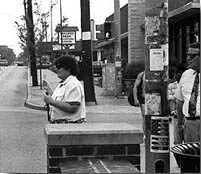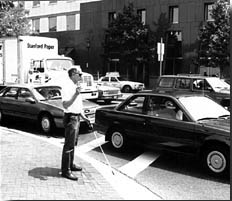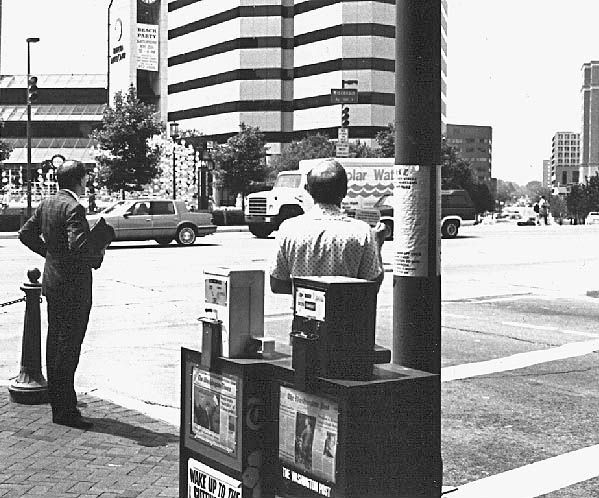In these sessions, two interviewers stood apart from the deaf-blind person (about 20 feet away) to ask questions of the people who passed by, and one interviewer waited across the street to ask questions of those who helped him or her cross the street.
For the second session (with the deaf-blind man) the questions were changed, based on the experiences in the first session surveying people passing by or helping the deaf-blind woman.
Below are the questions that were asked of the people who passed by or stopped to help the deaf-blind people across the street.
Questions asked of anyone who passed by or stopped to help the deaf-blind woman
Questions asked of anyone who helped the deaf-blind man across
Questions asked of anyone who did not help the deaf-blind man across
FIRST SESSION

Questions Asked of Anyone Who Passed By or Stopped to Help the Deaf-Blind Woman
These questions were asked verbally of each person who passed by or stopped to help the deaf-blind woman. Some of them have follow-up questions if the person responded in certain ways.
The interviewer noted which card was used, whether the person passed near the deaf-blind woman, whether or not the person glanced at the card or stopped to read the card, and whether the person helped the deaf-blind woman across, in which case questions #1 and #5 were skipped.
1. We are conducting a research project. Do you mind if I ask you why you think the woman with the cane is/was standing there?
2. In what way is she handicapped?
[If deafness is not mentioned, ask "Could she be deaf?" Y/N___]
3. Did you get a chance to read the card? Y/N____
[If yes, why do you think you didnít realize the person was deaf?]
[If they have no idea, ask if they were incredulous? Not paying attention? Not thinking?]
4. How did you feel when you saw that woman?
[If they have no idea, ask if they wanted to help? Felt cautious? Curious? Feeling pity? Angry? Afraid?]
5. Would you be reluctant to approach the woman? Y/N___ Why?
[Would you be reluctant if you had time, or if you knew she needed assistance?]
 SECOND SESSION
SECOND SESSION
Sample of Questions Asked of Anyone Who Helped the Deaf-Blind Man Across
The interviewer noted whether the person was a man or woman, which card the subject used, and comments about the personís approach to the deaf-blind man (such as stopped to read card, never looked in his direction, seemed in a hurry, talking with someone else, etc.)
1. Did you see or read his card? Y/N___ [If yes, when did you see the card, and how much of it did you read?]
2. Did you realize that he is deaf?
A. ____ NO -- If you read the card, how could have made it more clear that he is deaf?
B. ____ YES -- When did you realize, and how did you know?
[If the person talked to the subject, ask: Did you think he could understand you when you talked to him? Y/N___ ]
3. How did you know that he needed help to cross the street?
Would you have helped him if he hadnít used a card?
4. Any comments about the experience?
THANK YOU!
 SECOND SESSION
SECOND SESSION
Sample of Questions Asked of Anyone Who Did Not Help the Deaf-Blind Man Across
Interviewer noted which card was used, whether the person glanced at the deaf-blind man, whether or not the person could have seen the card from where he or she passed the deaf-blind man and if so from what distance, and whether or not the person stopped to read the card.
1. We are conducting a research project. Do you mind if I ask you if you saw that man and the card that he is holding? Y/N___
If yes:
2. How much of the card were you able to read?
3. Why did you think he was holding up the card?
[If the answer is ambiguous, ask "Did you think perhaps he was using the card for soliciting or asking for a handout, or getting help to cross the street?"]
4. Do you think that he:
Can cross the street independently? [If you thought he needed help and you werenít in a hurry, would you approach him to help? Y/N___]
Cannot cross the street independently? [Under what circumstances would you be willing to approach him to help him cross?]
THANK YOU
Return to Corner to Corner poster
Return to home page

 SECOND SESSION
SECOND SESSION SECOND SESSION
SECOND SESSION